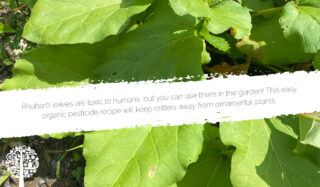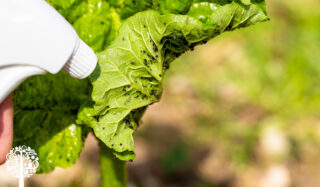If you grow rhubarb at home, you probably think about making muffins, pies, and jams. But how about a homemade organic pesticide? It’s no secret that we can’t eat rhubarb leaves because they’re toxic, but we can still put them to excellent use in the garden!

Pretty But Poison
Rhubarb leaves are beautiful because they’re green and big and provide excellent ground cover. I have a lovely plant I’ve brought from house to house with me, and it’s a favourite because it’s always one of the first things to sprout in the spring and is super fast-growing.
While the stalks are edible, the leaves contain high amounts of oxalic acid, which can cause gastrointestinal symptoms, kidney stones, and even kidney failure.
The good news is rhubarb leaves are also bad for some pests that enjoy nibbling on our gardens. A homemade insecticide made with chopped leaves from the plant can help eliminate aphids, spider mites, and caterpillars.
Where To Use Rhubarb Spray
However, after researching this topic, I’ll only use this solution when pests attack my flowers and other ornamental plants.

I won’t use it on my fruits and vegetables; even though I wash them well after harvest, I worry that any remaining residue from the rhubarb leaves will make us sick. I recommend checking out our other organic and safe suggestions for aphid and cabbage worm control.
But if you spot some pests devouring your marigolds, hostas, decorative cabbages and nasturtiums, go ahead and use the spray. Just ensure your cats or dogs don’t lick the solution off the plants; they can get sick too.
As for our other friendly pollinators, scientists have discovered oxalic acid will not harm bees, so go ahead and get brewing.
Making Rhubarb Spray
This homemade solution comes together quickly. All you need is:
- 1 cup of chopped rhubarb leaves
- 6 cups of water
- ¼ cup of dish soap
- A spray bottle
- Boil the leaves in the water for about half an hour.
- Remove from the heat and cool before straining the liquid into the spray bottle.
- Add the dish soap to the bottle and shake well to combine.
You’re all set! Remember to follow the safety guidelines; using this spray to eliminate bugs from ornamental plants and flowers is best.
If you need another idea for rhubarb leaves, check out my DIY stepping stones project!